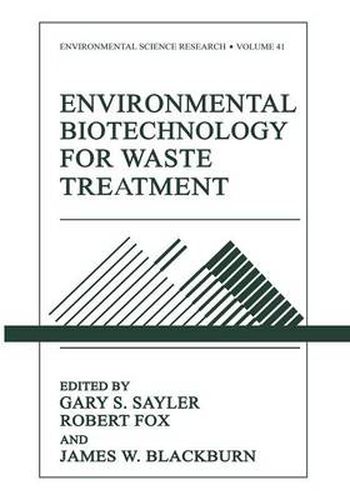Readings Newsletter
Become a Readings Member to make your shopping experience even easier.
Sign in or sign up for free!
You’re not far away from qualifying for FREE standard shipping within Australia
You’ve qualified for FREE standard shipping within Australia
The cart is loading…






This title is printed to order. This book may have been self-published. If so, we cannot guarantee the quality of the content. In the main most books will have gone through the editing process however some may not. We therefore suggest that you be aware of this before ordering this book. If in doubt check either the author or publisher’s details as we are unable to accept any returns unless they are faulty. Please contact us if you have any questions.
The use of biotechnical processes in control of environmental pollution and in haz ardous waste treatment is viewed as an advantageous alternative or adduct to phys ical chemical treatment technologies. Yet, the development and implementation of both conventional and advanced biotechnologies in predictable and efficacious field applications suffer from numerous technical, regulatory, and societal uncertainties. With the application of modern molecular biology and genetic engineering, there is clear potential for biotechnical developments that will lead to breakthroughs in controlled and optimized hazardous waste treatment for in situ and unit process use. There is, however, great concern that the development of these technologies may be needlessly hindered in their applications and that the fundamental research base may not be able to sustain continued technology development. Some of these issues have been discussed in a fragmented fashion within the research and development community. A basic research agenda has been established to promote a sustainable cross-disciplinary technology base. This agenda includes developing new and improved strains for biodegradation, improving bioanalytical methods to measure strain and biodegradation performance, and providing an in tegrated environmental and reactor systems analysis approach for process control and optimization.
$9.00 standard shipping within Australia
FREE standard shipping within Australia for orders over $100.00
Express & International shipping calculated at checkout
This title is printed to order. This book may have been self-published. If so, we cannot guarantee the quality of the content. In the main most books will have gone through the editing process however some may not. We therefore suggest that you be aware of this before ordering this book. If in doubt check either the author or publisher’s details as we are unable to accept any returns unless they are faulty. Please contact us if you have any questions.
The use of biotechnical processes in control of environmental pollution and in haz ardous waste treatment is viewed as an advantageous alternative or adduct to phys ical chemical treatment technologies. Yet, the development and implementation of both conventional and advanced biotechnologies in predictable and efficacious field applications suffer from numerous technical, regulatory, and societal uncertainties. With the application of modern molecular biology and genetic engineering, there is clear potential for biotechnical developments that will lead to breakthroughs in controlled and optimized hazardous waste treatment for in situ and unit process use. There is, however, great concern that the development of these technologies may be needlessly hindered in their applications and that the fundamental research base may not be able to sustain continued technology development. Some of these issues have been discussed in a fragmented fashion within the research and development community. A basic research agenda has been established to promote a sustainable cross-disciplinary technology base. This agenda includes developing new and improved strains for biodegradation, improving bioanalytical methods to measure strain and biodegradation performance, and providing an in tegrated environmental and reactor systems analysis approach for process control and optimization.